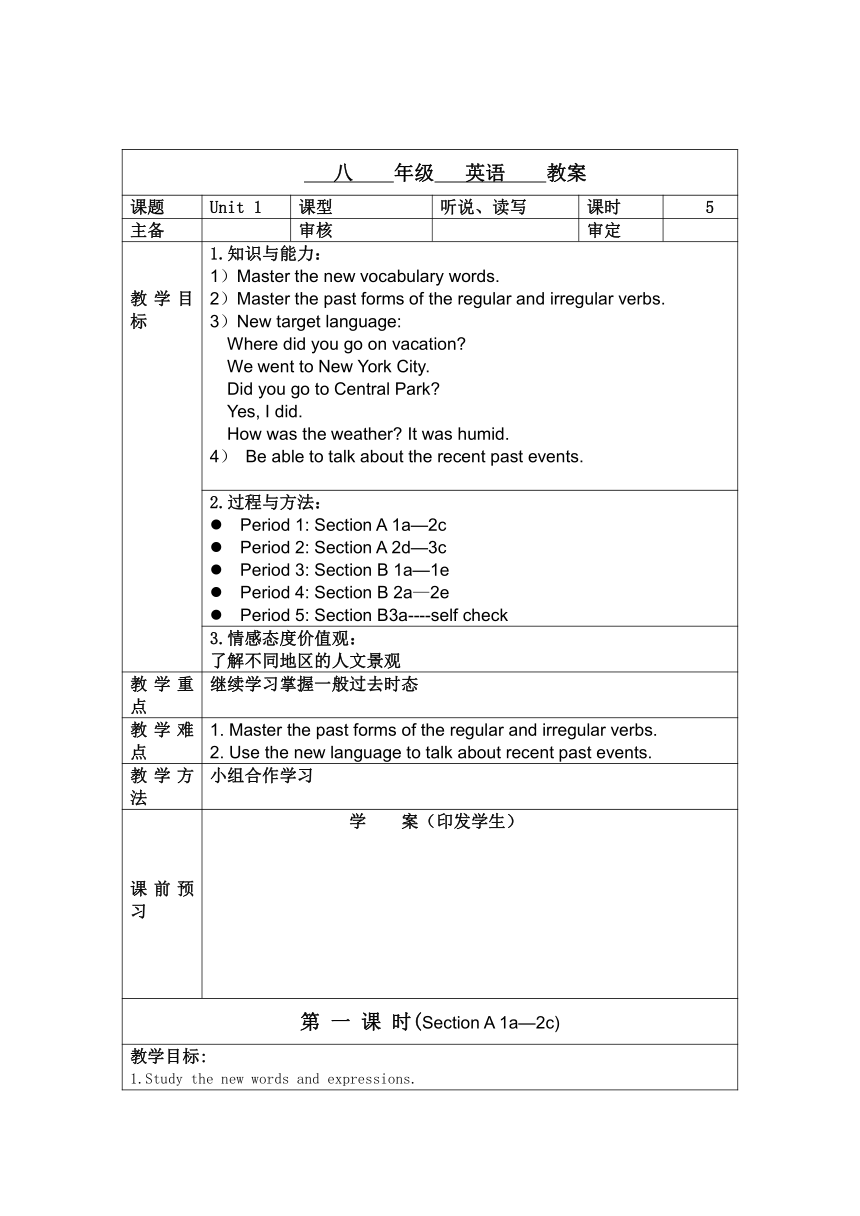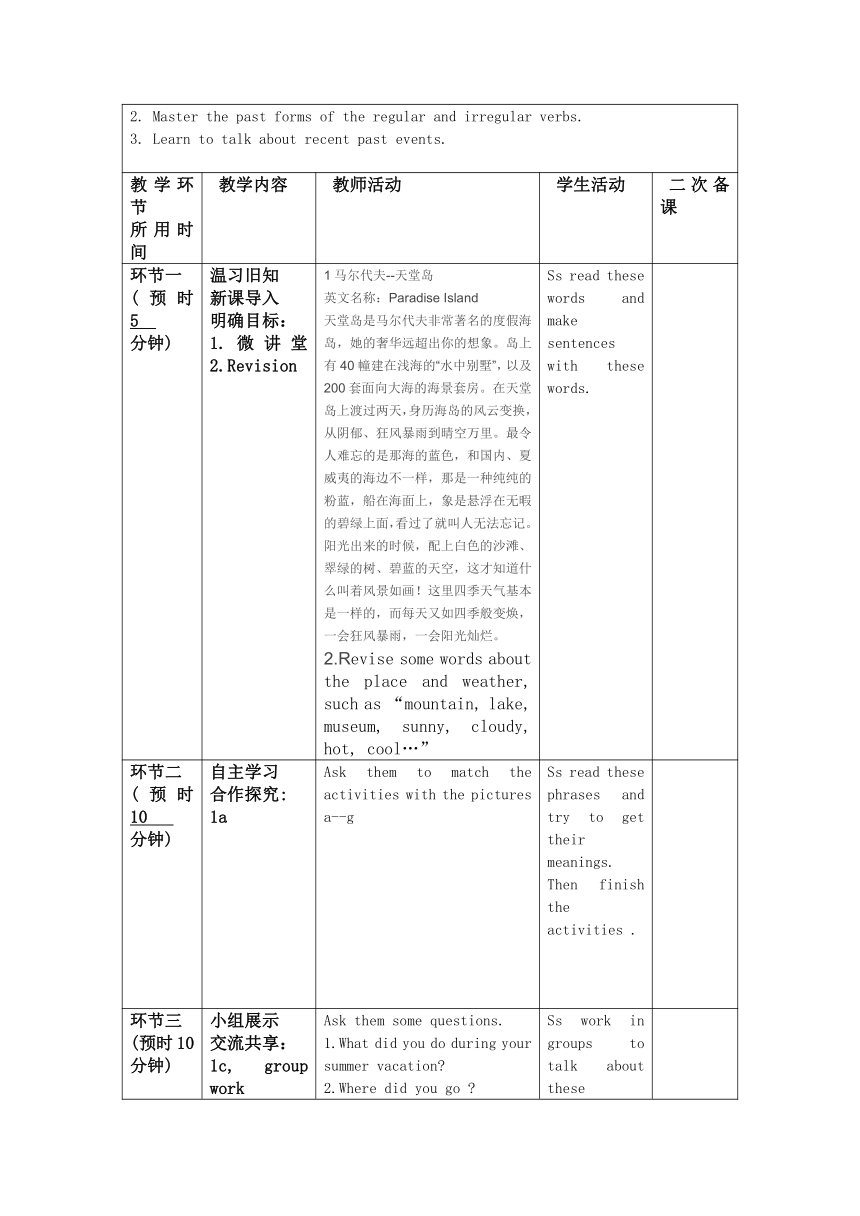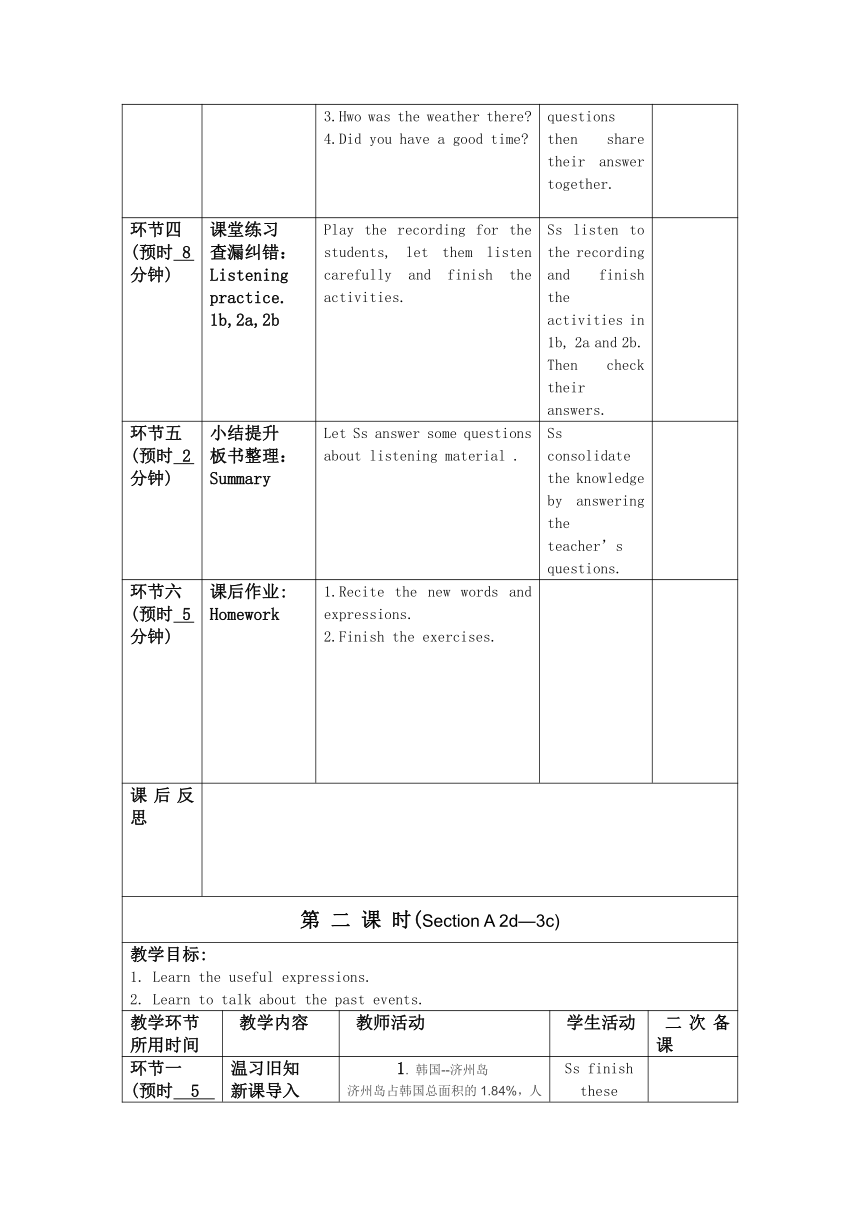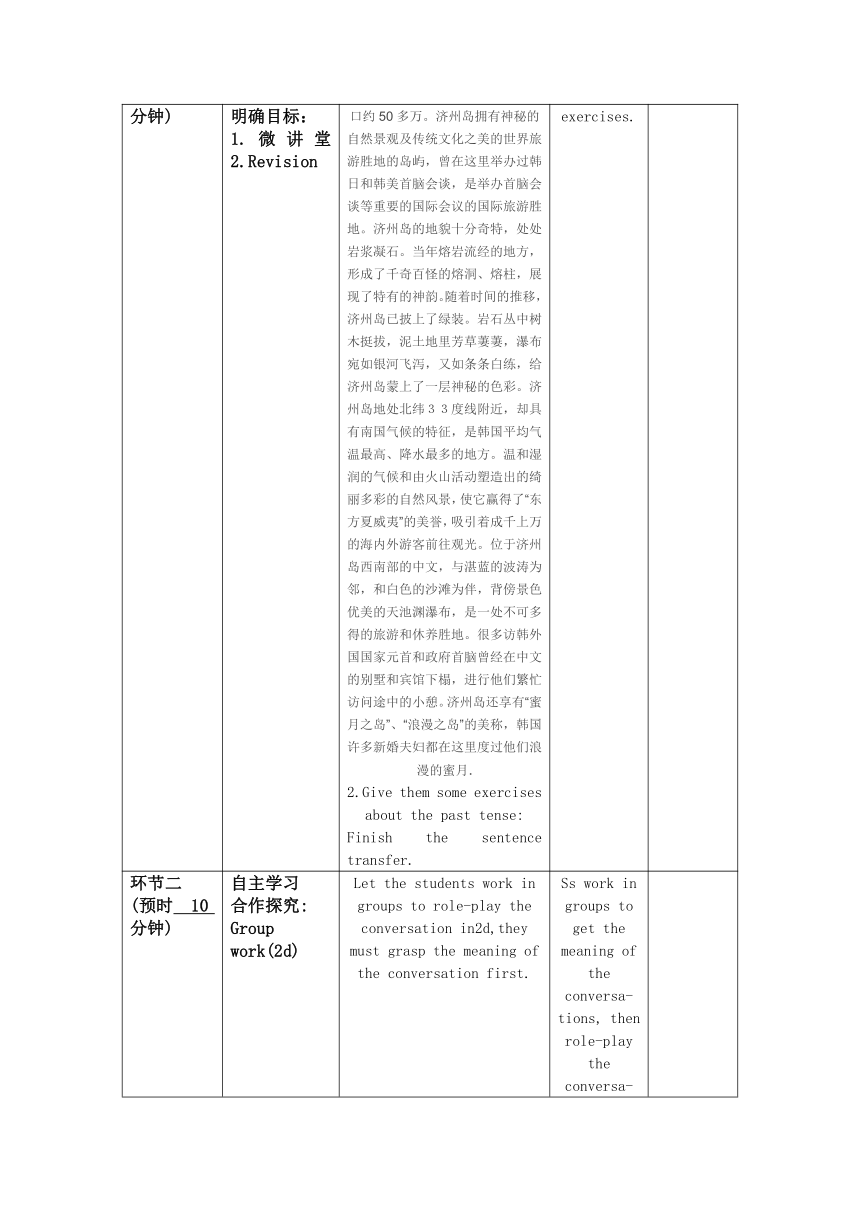八年级英语上册Unit 1 Where did you go on vacation? 教学设计教案(表格式)
文档属性
| 名称 | 八年级英语上册Unit 1 Where did you go on vacation? 教学设计教案(表格式) |  | |
| 格式 | zip | ||
| 文件大小 | 37.7KB | ||
| 资源类型 | 教案 | ||
| 版本资源 | 人教新目标(Go for it)版 | ||
| 科目 | 英语 | ||
| 更新时间 | 2023-04-12 13:41:44 | ||
图片预览





文档简介
八 年级 英语 教案
课题 Unit 1 课型 听说、读写 课时 5
主备 审核 审定
教学目标 1.知识与能力: 1)Master the new vocabulary words. 2)Master the past forms of the regular and irregular verbs. 3)New target language: Where did you go on vacation We went to New York City. Did you go to Central Park Yes, I did. How was the weather It was humid. 4) Be able to talk about the recent past events.
2.过程与方法: Period 1: Section A 1a—2c Period 2: Section A 2d—3c Period 3: Section B 1a—1e Period 4: Section B 2a—2e Period 5: Section B3a----self check
3.情感态度价值观: 了解不同地区的人文景观
教学重点 继续学习掌握一般过去时态
教学难点 1. Master the past forms of the regular and irregular verbs. 2. Use the new language to talk about recent past events.
教学方法 小组合作学习
课前预习 学 案(印发学生)
第 一 课 时(Section A 1a—2c)
教学目标: 1.Study the new words and expressions. 2. Master the past forms of the regular and irregular verbs. 3. Learn to talk about recent past events.
教学环节 所用时间 教学内容 教师活动 学生活动 二次备课
环节一 (预时 5 分钟) 温习旧知 新课导入 明确目标: 1.微讲堂2.Revision 1马尔代夫--天堂岛
英文名称:Paradise Island
天堂岛是马尔代夫非常著名的度假海岛,她的奢华远超出你的想象。岛上有40幢建在浅海的“水中别墅”,以及200套面向大海的海景套房。在天堂岛上渡过两天,身历海岛的风云变换,从阴郁、狂风暴雨到晴空万里。最令人难忘的是那海的蓝色,和国内、夏威夷的海边不一样,那是一种纯纯的粉蓝,船在海面上,象是悬浮在无暇的碧绿上面,看过了就叫人无法忘记。阳光出来的时候,配上白色的沙滩、翠绿的树、碧蓝的天空,这才知道什么叫着风景如画!这里四季天气基本是一样的,而每天又如四季般变焕,一会狂风暴雨,一会阳光灿烂。 2.Revise some words about the place and weather, such as “mountain, lake, museum, sunny, cloudy, hot, cool…” Ss read these words and make sentences with these words.
环节二 (预时 10 分钟) 自主学习 合作探究: 1a Ask them to match the activities with the pictures a--g Ss read these phrases and try to get their meanings. Then finish the activities .
环节三 (预时10 分钟) 小组展示 交流共享: 1c, group work Ask them some questions. 1.What did you do during your summer vacation 2.Where did you go 3.Hwo was the weather there 4.Did you have a good time Ss work in groups to talk about these questions then share their answer together.
环节四 (预时 8 分钟) 课堂练习 查漏纠错: Listening practice. 1b,2a,2b Play the recording for the students, let them listen carefully and finish the activities. Ss listen to the recording and finish the activities in 1b, 2a and 2b. Then check their answers.
环节五 (预时 2 分钟) 小结提升 板书整理: Summary Let Ss answer some questions about listening material . Ss consolidate the knowledge by answering the teacher’s questions.
环节六 (预时 5 分钟) 课后作业: Homework 1.Recite the new words and expressions. 2.Finish the exercises.
课后反思
第 二 课 时(Section A 2d—3c)
教学目标: 1. Learn the useful expressions. 2. Learn to talk about the past events.
教学环节 所用时间 教学内容 教师活动 学生活动 二次备课
环节一 (预时 5 分钟) 温习旧知 新课导入 明确目标: 1.微讲堂2.Revision 1. 韩国--济州岛
济州岛占韩国总面积的1.84%,人口约50多万。济州岛拥有神秘的自然景观及传统文化之美的世界旅游胜地的岛屿,曾在这里举办过韩日和韩美首脑会谈,是举办首脑会谈等重要的国际会议的国际旅游胜地。济州岛的地貌十分奇特,处处岩浆凝石。当年熔岩流经的地方,形成了千奇百怪的熔洞、熔柱,展现了特有的神韵。随着时间的推移,济州岛已披上了绿装。岩石丛中树木挺拔,泥土地里芳草萋萋,瀑布宛如银河飞泻,又如条条白练,给济州岛蒙上了一层神秘的色彩。 济州岛地处北纬33度线附近,却具有南国气候的特征,是韩国平均气温最高、降水最多的地方。温和湿润的气候和由火山活动塑造出的绮丽多彩的自然风景,使它赢得了“东方夏威夷”的美誉,吸引着成千上万的海内外游客前往观光。位于济州岛西南部的中文,与湛蓝的波涛为邻,和白色的沙滩为伴,背傍景色优美的天池渊瀑布,是一处不可多得的旅游和休养胜地。很多访韩外国国家元首和政府首脑曾经在中文的别墅和宾馆下榻,进行他们繁忙访问途中的小憩。济州岛还享有“蜜月之岛”、“浪漫之岛”的美称,韩国许多新婚夫妇都在这里度过他们浪漫的蜜月.
2.Give them some exercises about the past tense: Finish the sentence transfer. Ss finish these exercises.
环节二 (预时 10 分钟) 自主学习 合作探究: Group work(2d) Let the students work in groups to role-play the conversation in2d,they must grasp the meaning of the conversation first. Ss work in groups to get the meaning of the conversa- tions, then role-play the conversa- tion.
环节三 (预时 5 分钟) 小组展示 交流共享: Grammar focus. Let them read these sentences and try to remember them immediately . Ss read these sentences loudly and try to remember them.
环节四 (预时 10 分钟) 课堂练习 查漏纠错: Consolidation.(3a,3b) Let Ss finish these exercises in 3a and 3b ,then check their answers. Ss finish the exercises carefully and then check answers together.
环节五 (预时 5 分钟) 小结提升 板书整理: Group work(3c) Let Ss work in groups to ask questions about their last vacation, then fill in the form. Ss work in groups to ask each other questions, then share their results together.
环节六 (预时 5 分钟) 课后作业: Homework 1.Recite the new words and expressions. 2.Finish the exercises of this part.
课后反思
第 三 课 时(Section B 1a—1e)
教学目标: 1.Study the new words and expressions. 2.improve their ability of listening.
教学环节 所用时间 教学内容 教师活动 学生活动 二次备课
环节一 (预时 5 分钟) 温习旧知 新课导入 明确目标: 1.微讲堂2.Revision 1.瑞士--阿尔卑斯山
阿尔卑斯山是欧洲最高大、最雄伟的山脉。可谓是瑞士最靓丽的一条风景线。“艾格尔峰”、“明希峰”、“少女峰”三大名山均屹立在阿尔卑斯山脉。它位于瑞士的东南部,阿尔卑斯山区占瑞士总面积的69%。特殊的地理环境造就了它独特的景观:高山植物和雪绒花,湍急的瀑布,岩洞中的石钟乳,独特的动植物等。世界著名的滑雪胜地——圣莫里茨高山滑雪场就位于阿尔卑斯山脉的中心地带,是高山滑雪的胜地,曾成功举办过两届冬奥会。这里有海拔超过3000米的高山滑道,让你可以化身为翱翔在白色世界里的雪域雄鹰。冬日的阿尔卑斯山,白雪皑皑,冰川连绵千里,银白色的山坡陡斜雄伟,是滑雪的最佳场所,也是冬季运动比赛的热门场地。除1928年和1948年的冬季奥林匹克运动会外,1934年、1948年、1974年和2003年的世界滑雪锦标赛均在此举办,而奥林匹克雪橇赛和克莱斯特雪橇赛也都指定这里为比赛场地。
2.Dictate the sentences in grammar focus. Ss write down the sentences correctly.
环节二 (预时 5 分钟) 自主学习 合作探究: 1a,1b 1Ask the students to get the meaning of these words then finish the activity in1a.Finally,check their answers. 2.Finish the activity in 1b. Ss read these words in 1a then match these words with the pictures. Finish the activity in 1b.
环节三 (预时 15 分钟) 小组展示 交流共享: Listening practice.(1c, 1d) Play the recording for the first time ,let them listen and finish the exercise in 1c, then play the recording again and finish the activity in 1d. Then check their answers. Ss listen to the recording carefully and answer the questions in 1c.Then listen again and fill in the blanks in 1d.
环节四 (预时 10 分钟) 课堂练习 查漏纠错: 1e Let Ss read the listening material then ask and answer questions about Lisa’s vacation. Ss read the listening material and answer these questions.
环节五 (预时 5 分钟) 课后作业: Homework 1.Recite the new words and expressions. 2.Finish the exercises of this part.
课后反思
第 四 课 时(Section B 2a—2e)
教学目标: 1.Study the new words and expressions. 2.Improve their ability of reading. 3.Find out some useful phrases.
教学环节 所用时间 教学内容 教师活动 学生活动 二次备课
环节一 (预时 5 分钟) 温习旧知 新课导入 明确目标: 1.微讲堂 2.Revision 1. 阿根廷--阿根廷湖
坐落于阿根廷南部圣克鲁斯省的冰川湖,面积1414平方公里,这里以著名冰块堆积景观而闻名于世。该湖接纳来自周围150多条冰河的冰流和冰块。巨大的冰块互相撞击,缓缓向前移动,有时形成
造型奇特的冰墙,高达80米。最后全部汇积到阿根廷湖,组成了洁白玉立的冰山雕塑。湖畔雪峰环绕,山下林木茂盛,景色迷人,为阿根廷最引人入胜的旅游景点。 2.Dictation. Ss get to know the knowledge of Argentina.
环节二 (预时 15 分钟) 自主学习 合作探究: 2a,2b 1.Let them answer the questions in 2a. 2.Let them read the diary in2b and answer the questions. 3.Encourage the Ss to read the diary again and get the meaning of them 1.Ss read the diary and finish the teacher’s activity. 2Encourage them to find out some useful expression.
环节三 (预时 10 分钟) 小组展示 交流共享: 2c,2d, 2e Reading comprehension. 1.Give them some time to finish the exercises in 2c,2d and 2e. 2.Let them check their answers by themselves. Ss finish the exercises individually ,if they have some problems ,give them some help.
环节四 (预时 5 分钟) 课堂练习 查漏纠错: Consolidation. Point out the mistakes in their exercises, and let them correct them. Ss write down the useful language points, and try to remember them.
环节五 (预时 5 分钟) 小结提升 板书整理: Summarize arrive in/at decide to feel like excited/exciting enjoy want to start to/ding Ss write down these on their note book.
环节六 (预时 分钟) 课后作业: Homework 1.Remember the language points. 2. Finish the exercises.
课后反思
第 五 课 时(Section B3a----self check)
教学目标: 1.Study the new words and expressions. 2.Improve the ability of writing. 3. So some exercises.
教学环节 所用时间 教学内容 教师活动 学生活动 二次备课
环节一 (预时 5 分钟) 温习旧知 新课导入 明确目标: 1.微讲堂 2.Revision 1.意大利--比萨斜塔
1.英文名称:The Leaning Tower of Pisa
比萨斜塔竣工于1350年,但是工程早于1174年就开始了。当年,工程进行到第三层时,人们就发现,由于地基、建筑结构等原因,塔身出现了倾斜。于是工程中断了。后来,当政者变了,又延请了新建筑师继续了此工程。随着时间的推移,比萨塔的倾斜程度不断增大,目前已达到4.5米,而且倾斜度还以每年1毫米的速度继续增加。为了确保游人的安全,并保护这一罕见的古迹,避免其因过度倾斜而倒塌,意大利政府不得不于1990年取消了比萨斜塔的对外开放,加固和纠偏工程自此开始。在2000年,比萨斜塔重新对游人开放。 2.Dictation Ss study the knowledge . Finish the dictation.
环节二 (预时 5 分钟) 自主学习 合作探究: 3a 1.Let the Ss complete the diary by using the words in the box. 2.Check their answers. Ss fill in the blanks and get the meaning of the diary.
环节三 (预时 5 分钟) 小组展示 交流共享: 3b Encourage them to answer these questions. Make notes about a vacation . Ss answer these questions by themselves.
环节四 (预时 10 分钟 课堂练习 查漏纠错: 3c Let them write a travel like Jane’s on p5, use the notes in 3b Ss write a diary about their vacation
环节五 (预时 10 分钟) 小结提升 板书整理: Self check Let them finish the exercises in Self check. Then check their answers. Ss finish these exercises.
环节六 (预时 5 分钟) 课后作业: Homework 1.Recite the new words and expressions. 2.Finish the exercises of this part.
课后反思
课题 Unit 1 课型 听说、读写 课时 5
主备 审核 审定
教学目标 1.知识与能力: 1)Master the new vocabulary words. 2)Master the past forms of the regular and irregular verbs. 3)New target language: Where did you go on vacation We went to New York City. Did you go to Central Park Yes, I did. How was the weather It was humid. 4) Be able to talk about the recent past events.
2.过程与方法: Period 1: Section A 1a—2c Period 2: Section A 2d—3c Period 3: Section B 1a—1e Period 4: Section B 2a—2e Period 5: Section B3a----self check
3.情感态度价值观: 了解不同地区的人文景观
教学重点 继续学习掌握一般过去时态
教学难点 1. Master the past forms of the regular and irregular verbs. 2. Use the new language to talk about recent past events.
教学方法 小组合作学习
课前预习 学 案(印发学生)
第 一 课 时(Section A 1a—2c)
教学目标: 1.Study the new words and expressions. 2. Master the past forms of the regular and irregular verbs. 3. Learn to talk about recent past events.
教学环节 所用时间 教学内容 教师活动 学生活动 二次备课
环节一 (预时 5 分钟) 温习旧知 新课导入 明确目标: 1.微讲堂2.Revision 1马尔代夫--天堂岛
英文名称:Paradise Island
天堂岛是马尔代夫非常著名的度假海岛,她的奢华远超出你的想象。岛上有40幢建在浅海的“水中别墅”,以及200套面向大海的海景套房。在天堂岛上渡过两天,身历海岛的风云变换,从阴郁、狂风暴雨到晴空万里。最令人难忘的是那海的蓝色,和国内、夏威夷的海边不一样,那是一种纯纯的粉蓝,船在海面上,象是悬浮在无暇的碧绿上面,看过了就叫人无法忘记。阳光出来的时候,配上白色的沙滩、翠绿的树、碧蓝的天空,这才知道什么叫着风景如画!这里四季天气基本是一样的,而每天又如四季般变焕,一会狂风暴雨,一会阳光灿烂。 2.Revise some words about the place and weather, such as “mountain, lake, museum, sunny, cloudy, hot, cool…” Ss read these words and make sentences with these words.
环节二 (预时 10 分钟) 自主学习 合作探究: 1a Ask them to match the activities with the pictures a--g Ss read these phrases and try to get their meanings. Then finish the activities .
环节三 (预时10 分钟) 小组展示 交流共享: 1c, group work Ask them some questions. 1.What did you do during your summer vacation 2.Where did you go 3.Hwo was the weather there 4.Did you have a good time Ss work in groups to talk about these questions then share their answer together.
环节四 (预时 8 分钟) 课堂练习 查漏纠错: Listening practice. 1b,2a,2b Play the recording for the students, let them listen carefully and finish the activities. Ss listen to the recording and finish the activities in 1b, 2a and 2b. Then check their answers.
环节五 (预时 2 分钟) 小结提升 板书整理: Summary Let Ss answer some questions about listening material . Ss consolidate the knowledge by answering the teacher’s questions.
环节六 (预时 5 分钟) 课后作业: Homework 1.Recite the new words and expressions. 2.Finish the exercises.
课后反思
第 二 课 时(Section A 2d—3c)
教学目标: 1. Learn the useful expressions. 2. Learn to talk about the past events.
教学环节 所用时间 教学内容 教师活动 学生活动 二次备课
环节一 (预时 5 分钟) 温习旧知 新课导入 明确目标: 1.微讲堂2.Revision 1. 韩国--济州岛
济州岛占韩国总面积的1.84%,人口约50多万。济州岛拥有神秘的自然景观及传统文化之美的世界旅游胜地的岛屿,曾在这里举办过韩日和韩美首脑会谈,是举办首脑会谈等重要的国际会议的国际旅游胜地。济州岛的地貌十分奇特,处处岩浆凝石。当年熔岩流经的地方,形成了千奇百怪的熔洞、熔柱,展现了特有的神韵。随着时间的推移,济州岛已披上了绿装。岩石丛中树木挺拔,泥土地里芳草萋萋,瀑布宛如银河飞泻,又如条条白练,给济州岛蒙上了一层神秘的色彩。 济州岛地处北纬33度线附近,却具有南国气候的特征,是韩国平均气温最高、降水最多的地方。温和湿润的气候和由火山活动塑造出的绮丽多彩的自然风景,使它赢得了“东方夏威夷”的美誉,吸引着成千上万的海内外游客前往观光。位于济州岛西南部的中文,与湛蓝的波涛为邻,和白色的沙滩为伴,背傍景色优美的天池渊瀑布,是一处不可多得的旅游和休养胜地。很多访韩外国国家元首和政府首脑曾经在中文的别墅和宾馆下榻,进行他们繁忙访问途中的小憩。济州岛还享有“蜜月之岛”、“浪漫之岛”的美称,韩国许多新婚夫妇都在这里度过他们浪漫的蜜月.
2.Give them some exercises about the past tense: Finish the sentence transfer. Ss finish these exercises.
环节二 (预时 10 分钟) 自主学习 合作探究: Group work(2d) Let the students work in groups to role-play the conversation in2d,they must grasp the meaning of the conversation first. Ss work in groups to get the meaning of the conversa- tions, then role-play the conversa- tion.
环节三 (预时 5 分钟) 小组展示 交流共享: Grammar focus. Let them read these sentences and try to remember them immediately . Ss read these sentences loudly and try to remember them.
环节四 (预时 10 分钟) 课堂练习 查漏纠错: Consolidation.(3a,3b) Let Ss finish these exercises in 3a and 3b ,then check their answers. Ss finish the exercises carefully and then check answers together.
环节五 (预时 5 分钟) 小结提升 板书整理: Group work(3c) Let Ss work in groups to ask questions about their last vacation, then fill in the form. Ss work in groups to ask each other questions, then share their results together.
环节六 (预时 5 分钟) 课后作业: Homework 1.Recite the new words and expressions. 2.Finish the exercises of this part.
课后反思
第 三 课 时(Section B 1a—1e)
教学目标: 1.Study the new words and expressions. 2.improve their ability of listening.
教学环节 所用时间 教学内容 教师活动 学生活动 二次备课
环节一 (预时 5 分钟) 温习旧知 新课导入 明确目标: 1.微讲堂2.Revision 1.瑞士--阿尔卑斯山
阿尔卑斯山是欧洲最高大、最雄伟的山脉。可谓是瑞士最靓丽的一条风景线。“艾格尔峰”、“明希峰”、“少女峰”三大名山均屹立在阿尔卑斯山脉。它位于瑞士的东南部,阿尔卑斯山区占瑞士总面积的69%。特殊的地理环境造就了它独特的景观:高山植物和雪绒花,湍急的瀑布,岩洞中的石钟乳,独特的动植物等。世界著名的滑雪胜地——圣莫里茨高山滑雪场就位于阿尔卑斯山脉的中心地带,是高山滑雪的胜地,曾成功举办过两届冬奥会。这里有海拔超过3000米的高山滑道,让你可以化身为翱翔在白色世界里的雪域雄鹰。冬日的阿尔卑斯山,白雪皑皑,冰川连绵千里,银白色的山坡陡斜雄伟,是滑雪的最佳场所,也是冬季运动比赛的热门场地。除1928年和1948年的冬季奥林匹克运动会外,1934年、1948年、1974年和2003年的世界滑雪锦标赛均在此举办,而奥林匹克雪橇赛和克莱斯特雪橇赛也都指定这里为比赛场地。
2.Dictate the sentences in grammar focus. Ss write down the sentences correctly.
环节二 (预时 5 分钟) 自主学习 合作探究: 1a,1b 1Ask the students to get the meaning of these words then finish the activity in1a.Finally,check their answers. 2.Finish the activity in 1b. Ss read these words in 1a then match these words with the pictures. Finish the activity in 1b.
环节三 (预时 15 分钟) 小组展示 交流共享: Listening practice.(1c, 1d) Play the recording for the first time ,let them listen and finish the exercise in 1c, then play the recording again and finish the activity in 1d. Then check their answers. Ss listen to the recording carefully and answer the questions in 1c.Then listen again and fill in the blanks in 1d.
环节四 (预时 10 分钟) 课堂练习 查漏纠错: 1e Let Ss read the listening material then ask and answer questions about Lisa’s vacation. Ss read the listening material and answer these questions.
环节五 (预时 5 分钟) 课后作业: Homework 1.Recite the new words and expressions. 2.Finish the exercises of this part.
课后反思
第 四 课 时(Section B 2a—2e)
教学目标: 1.Study the new words and expressions. 2.Improve their ability of reading. 3.Find out some useful phrases.
教学环节 所用时间 教学内容 教师活动 学生活动 二次备课
环节一 (预时 5 分钟) 温习旧知 新课导入 明确目标: 1.微讲堂 2.Revision 1. 阿根廷--阿根廷湖
坐落于阿根廷南部圣克鲁斯省的冰川湖,面积1414平方公里,这里以著名冰块堆积景观而闻名于世。该湖接纳来自周围150多条冰河的冰流和冰块。巨大的冰块互相撞击,缓缓向前移动,有时形成
造型奇特的冰墙,高达80米。最后全部汇积到阿根廷湖,组成了洁白玉立的冰山雕塑。湖畔雪峰环绕,山下林木茂盛,景色迷人,为阿根廷最引人入胜的旅游景点。 2.Dictation. Ss get to know the knowledge of Argentina.
环节二 (预时 15 分钟) 自主学习 合作探究: 2a,2b 1.Let them answer the questions in 2a. 2.Let them read the diary in2b and answer the questions. 3.Encourage the Ss to read the diary again and get the meaning of them 1.Ss read the diary and finish the teacher’s activity. 2Encourage them to find out some useful expression.
环节三 (预时 10 分钟) 小组展示 交流共享: 2c,2d, 2e Reading comprehension. 1.Give them some time to finish the exercises in 2c,2d and 2e. 2.Let them check their answers by themselves. Ss finish the exercises individually ,if they have some problems ,give them some help.
环节四 (预时 5 分钟) 课堂练习 查漏纠错: Consolidation. Point out the mistakes in their exercises, and let them correct them. Ss write down the useful language points, and try to remember them.
环节五 (预时 5 分钟) 小结提升 板书整理: Summarize arrive in/at decide to feel like excited/exciting enjoy want to start to/ding Ss write down these on their note book.
环节六 (预时 分钟) 课后作业: Homework 1.Remember the language points. 2. Finish the exercises.
课后反思
第 五 课 时(Section B3a----self check)
教学目标: 1.Study the new words and expressions. 2.Improve the ability of writing. 3. So some exercises.
教学环节 所用时间 教学内容 教师活动 学生活动 二次备课
环节一 (预时 5 分钟) 温习旧知 新课导入 明确目标: 1.微讲堂 2.Revision 1.意大利--比萨斜塔
1.英文名称:The Leaning Tower of Pisa
比萨斜塔竣工于1350年,但是工程早于1174年就开始了。当年,工程进行到第三层时,人们就发现,由于地基、建筑结构等原因,塔身出现了倾斜。于是工程中断了。后来,当政者变了,又延请了新建筑师继续了此工程。随着时间的推移,比萨塔的倾斜程度不断增大,目前已达到4.5米,而且倾斜度还以每年1毫米的速度继续增加。为了确保游人的安全,并保护这一罕见的古迹,避免其因过度倾斜而倒塌,意大利政府不得不于1990年取消了比萨斜塔的对外开放,加固和纠偏工程自此开始。在2000年,比萨斜塔重新对游人开放。 2.Dictation Ss study the knowledge . Finish the dictation.
环节二 (预时 5 分钟) 自主学习 合作探究: 3a 1.Let the Ss complete the diary by using the words in the box. 2.Check their answers. Ss fill in the blanks and get the meaning of the diary.
环节三 (预时 5 分钟) 小组展示 交流共享: 3b Encourage them to answer these questions. Make notes about a vacation . Ss answer these questions by themselves.
环节四 (预时 10 分钟 课堂练习 查漏纠错: 3c Let them write a travel like Jane’s on p5, use the notes in 3b Ss write a diary about their vacation
环节五 (预时 10 分钟) 小结提升 板书整理: Self check Let them finish the exercises in Self check. Then check their answers. Ss finish these exercises.
环节六 (预时 5 分钟) 课后作业: Homework 1.Recite the new words and expressions. 2.Finish the exercises of this part.
课后反思
同课章节目录
- Unit 1 Where did you go on vacation?
- Section A
- Section B
- Unit 2 How often do you exercise?
- Section A
- Section B
- Unit 3 I'm more outgoing than my sister.
- Section A
- Section B
- Unit 4 What's the best movie theater?
- Section A
- Section B
- Unit 5 Do you want to watch a game show?
- Section A
- Section B
- Unit 6 I'm going to study computer science.
- Section A
- Section B
- Unit 7 Will people have robots?
- Section A
- Section B
- Unit 8 How do you make a banana milk shake?
- Section A
- Section B
- Unit 9 Can you come to my party?
- Section A
- Section B
- Unit 10 If you go to the party, you'll have a grea
- Section A
- Section B
